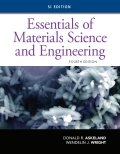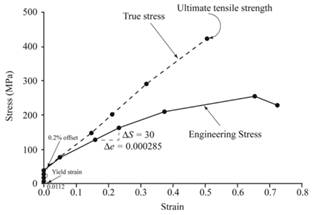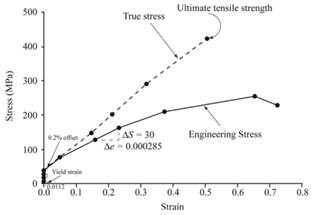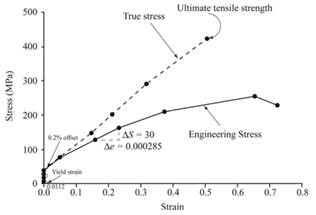
(a)
Interpretation:
The engineering stress-strain curve and true stress-strain curve should be plotted with the use of data provided of cold-rolled and annealed brass.
Concept Introduction:
Engineering stress is a term explained as a force or applied load on the given object's initial cross-sectional area and it is also known as nominal stress.
Engineering strain is a term representing the amount of deformation of the material in the direction of force applied divided by the initial material length.
True stress is the required amount of force that tends to deformation of the specimen.
True strain or reduction of area are defined as the length change of the specimen due to the applied force on it.
Answer to Problem 6.37P
Below graph represents the engineering stress-strain curve and true stress-strain curve given sample of cold-rolled and annealed brass.

Explanation of Solution
The tabular data providing details about the load and length difference for given sample is as follows:
Table:
| Load(N) | |
| 0 | 0.00000 |
| 66 | 0.0112 |
| 177 | 0.0157 |
| 327 | 0.0199 |
| 462 | 0.0240 |
| 797 | 1.72 |
| 1350 | 5.55 |
| 1720 | 8.15 |
| 2220 | 13.07 |
| 2690 | 22.77 (maximum load) |
| 2410 | 25.25 (fracture) |
Let us calculate the engineering stress for the sample with the help of below formula:
For determining the engineering strain of the given sample,
Now, find true strain as well as true stress with the help for below formulas:
- True strain:
- True stress:
Tabulate the data with the use of engineering stress, engineering strain, true strain and true stress as below:
| Load(N) | Displacement ( | Engineering stress (S) MPa | Engineering strain (e) | True strain ( | True stress( |
| 0 | 0.00000 | 0 | 2 | 0 | 0 |
| 66 | 0.0112 | 6.29 | 0.00032 | 0.00032 | 6.29 |
| 177 | 0.0157 | 16.86 | 0.00044 | 0.00044 | 16.87 |
| 327 | 0.0199 | 31.13 | 0.00056 | 0.00056 | 31.16 |
| 462 | 0.0240 | 44 | 0.00068 | 0.00068 | 43 |
| 797 | 1.72 | 75.90 | 0.04914 | 0.04797 | 79.54 |
| 1350 | 5.55 | 129 | 0.15857 | 0.14718 | 148 |
| 1720 | 8.15 | 164 | 0.23285 | 0.20932 | 198 |
| 2220 | 13.07 | 211 | 0.37342 | 0.31732 | 279 |
| 2690 | 22.77 | 256 | 0.65056 | 0.50111 | 423 |
| 2410 | 25.25 | 230 | 0.72142 | 0.54315 | 355 |
Now, plot the true stress-strain curve and engineering stress-strain curve from the above gathered tabular data as below:

(b)
Interpretation:
With the help of plotted engineering stress-strain curve and true stress-strain curve, the explanation should be given for relative values of true stress-strain and engineering stress-strain.
Concept Introduction:
Engineering stress is a term explained as a force or applied load on the given object's initial cross-sectional area and it is also known as nominal stress.
Engineering strain is a term representing the amount of deformation of the material in the direction of force applied divided by the initial material length.
True stress is the required amount of force that tends to deformation of the specimen.
True strain or reduction of area and defined as the length change of the specimen due to the applied force on it.
Answer to Problem 6.37P
At point of elastic loading and necking, less value of engineering stress and true strain is obtained while high value of true stress and engineering strain is obtained.
Explanation of Solution
Below graph represents the engineering stress-strain curve and true stress-strain curve given sample of cold-rolled and annealed brass.

When there is a phase of elastic formation, the values of engineering stress-strain and true stress-strain are found closer to each other but after reviewing closely, one can justify that the values of true stress are higher than engineering stress values while true strain values are lower than engineering strain values. At the point of yielding phase, the differences of values become higher.
When tension test is performed, the cross-section area of sample getting reduced and there is an elongation of length determined by using instantaneous length changes. This result into high value of engineering strain as compared to true strain and low values of engineering stress compared to true stress prior to necking.
(c)
Interpretation:
The explanation should be given for the curve if prior known data was provided for true stress and strain at the point of necking.
Concept Introduction:
Modulus of elasticity is also known as coefficient of elasticity or elastic modulus and can be defined as the ratio of the stress in the given object body to the corresponding strain.
Answer to Problem 6.37P
If prior known data was provided for true stress and strain at the point of necking, one gets the continuously rising curve of true stress without indicating any highest point in this curve.
Explanation of Solution
The tabular data with the use of engineering stress, engineering strain, true strain and true stress is as below:
| Load(N) | Displacement ( | Engineering stress (S) MPa | Engineering strain (e) | True strain ( | True stress( |
| 0 | 0.00000 | 0 | 2 | 0 | 0 |
| 66 | 0.0112 | 6.29 | 0.00032 | 0.00032 | 6.29 |
| 177 | 0.0157 | 16.86 | 0.00044 | 0.00044 | 16.87 |
| 327 | 0.0199 | 31.13 | 0.00056 | 0.00056 | 31.16 |
| 462 | 0.0240 | 44 | 0.00068 | 0.00068 | 43 |
| 797 | 1.72 | 75.90 | 0.04914 | 0.04797 | 79.54 |
| 1350 | 5.55 | 129 | 0.15857 | 0.14718 | 148 |
| 1720 | 8.15 | 164 | 0.23285 | 0.20932 | 198 |
| 2220 | 13.07 | 211 | 0.37342 | 0.31732 | 279 |
| 2690 | 22.77 | 256 | 0.65056 | 0.50111 | 423 |
| 2410 | 25.25 | 230 | 0.72142 | 0.54315 | 355 |
The known value of true stress and strain may have not given us the curve of true stress-strain with the highest point and rather it would have shown continuous rise in the true stress.
(d)
Interpretation:
With the help of plotted engineering and true stress-strain curve, the 0.2 % offset yield strength should be calculated for the given data of cold-rolled and annealed brass.
Concept Introduction:
The maximum amount of elastic deformation which is bearable by any material is defined as yield strength.
Answer to Problem 6.37P
The yield strength for 0.2% offset is 45 MPa for a given sample of cold-rolled and annealed brass.
Explanation of Solution
The tabular data with the use of engineering stress, engineering strain, true strain and true stress is as below:
| Load(N) | Displacement ( | Engineering stress (S) MPa | Engineering strain (e) | True strain ( | True stress( |
| 0 | 0.00000 | 0 | 2 | 0 | 0 |
| 66 | 0.0112 | 6.29 | 0.00032 | 0.00032 | 6.29 |
| 177 | 0.0157 | 16.86 | 0.00044 | 0.00044 | 16.87 |
| 327 | 0.0199 | 31.13 | 0.00056 | 0.00056 | 31.16 |
| 462 | 0.0240 | 44 | 0.00068 | 0.00068 | 43 |
| 797 | 1.72 | 75.90 | 0.04914 | 0.04797 | 79.54 |
| 1350 | 5.55 | 129 | 0.15857 | 0.14718 | 148 |
| 1720 | 8.15 | 164 | 0.23285 | 0.20932 | 198 |
| 2220 | 13.07 | 211 | 0.37342 | 0.31732 | 279 |
| 2690 | 22.77 | 256 | 0.65056 | 0.50111 | 423 |
| 2410 | 25.25 | 230 | 0.72142 | 0.54315 | 355 |
Below graph represents the engineering stress-strain curve and true stress-strain curve given sample of cold-rolled and annealed brass.

The above graph can provide the value of yield strength for 0.2% offset as 45 MPa.
Therefore, one can conclude that the given sample contains the yield strength for 0.2% offset as 45MPa.
(e)
Interpretation:
With the help of plotted engineering and true stress-strain curve, the tensile strength should be calculated for the given data of cold-rolled and annealed brass.
Concept Introduction:
The tensile strength can be defined as the measurement of maximum deformation which can be bearable by any material without undergoing necking condition.
Answer to Problem 6.37P
The tensile strength is 256.1MPa for a given sample of cold-rolled and annealed brass.
Explanation of Solution
The tabular data with the use of engineering stress, engineering strain, true strain and true stress is as below:
| Load(N) | Displacement ( | Engineering stress (S) MPa | Engineering strain (e) | True strain ( | True stress( |
| 0 | 0.00000 | 0 | 2 | 0 | 0 |
| 66 | 0.0112 | 6.29 | 0.00032 | 0.00032 | 6.29 |
| 177 | 0.0157 | 16.86 | 0.00044 | 0.00044 | 16.87 |
| 327 | 0.0199 | 31.13 | 0.00056 | 0.00056 | 31.16 |
| 462 | 0.0240 | 44 | 0.00068 | 0.00068 | 43 |
| 797 | 1.72 | 75.90 | 0.04914 | 0.04797 | 79.54 |
| 1350 | 5.55 | 129 | 0.15857 | 0.14718 | 148 |
| 1720 | 8.15 | 164 | 0.23285 | 0.20932 | 198 |
| 2220 | 13.07 | 211 | 0.37342 | 0.31732 | 279 |
| 2690 | 22.77 | 256 | 0.65056 | 0.50111 | 423 |
| 2410 | 25.25 | 230 | 0.72142 | 0.54315 | 355 |
Below graph represents the engineering stress-strain curve and true stress-strain curve given sample of cold-rolled and annealed brass.

The tensile strength can be determined by use of below mentioned formula:
Therefore, one can conclude that the given sample of cold-rolled and annealed brass has the tensile strength of 256.1MPa.
(f)
Interpretation:
With the help of plotted engineering and true stress-strain curve, the value of modulus of elasticity should be calculated for the given data of cold-rolled and annealed brass.
Concept Introduction:
Modulus of elasticity is also known as coefficient of elasticity or elastic modulus and can be defined as the ratio of the stress in the given object body to the corresponding strain.
Answer to Problem 6.37P
The value of modulus of elasticity is 105.2GPafor a given sample of cold-rolled and annealed brass.
Explanation of Solution
The tabular data with the use of engineering stress, engineering strain, true strain and true stress is as below:
| Load(N) | Displacement ( | Engineering stress (S) MPa | Engineering strain (e) | True strain ( | True stress( |
| 0 | 0.00000 | 0 | 2 | 0 | 0 |
| 66 | 0.0112 | 6.29 | 0.00032 | 0.00032 | 6.29 |
| 177 | 0.0157 | 16.86 | 0.00044 | 0.00044 | 16.87 |
| 327 | 0.0199 | 31.13 | 0.00056 | 0.00056 | 31.16 |
| 462 | 0.0240 | 44 | 0.00068 | 0.00068 | 43 |
| 797 | 1.72 | 75.90 | 0.04914 | 0.04797 | 79.54 |
| 1350 | 5.55 | 129 | 0.15857 | 0.14718 | 148 |
| 1720 | 8.15 | 164 | 0.23285 | 0.20932 | 198 |
| 2220 | 13.07 | 211 | 0.37342 | 0.31732 | 279 |
| 2690 | 22.77 | 256 | 0.65056 | 0.50111 | 423 |
| 2410 | 25.25 | 230 | 0.72142 | 0.54315 | 355 |
Below graph represents the engineering stress-strain curve and true stress-strain curve given sample of cold-rolled and annealed brass.

The modulus of elasticity can be determined by use of below mentioned formula:
In above equation,
Therefore, the value of modulus of elasticity for given cold-rolled and annealed brassas 105.2 GPa.
Want to see more full solutions like this?
Chapter 6 Solutions
Essentials of Materials Science and Engineering, SI Edition
- It is the middle of a winter snowstorm. Sally and Jin take shelter under an overhang. The loading of the snow on top of the overhang is shown in the figure below. The overhang is attached to the wall at points A and B with pin supports. Another pin is at C. Determine the reactions of the pin supports at A and B. Express them in Cartesian vector form.arrow_forwardPlease answer all questions 1. Calculate the magnitude (in RMS) of the current through R1 2. Calculate the magnitude (in RMS) of the current through R2. Simulation 1. Construct the circuit in Figure 2 in the Circuit JS simulator. Note that transformers in Circuit JS may be unstable. It is suggested to draw them by clicking from the bottom left corner to the top right corner and refresh your simulation before taking a measurement. 2. Perform a simulation, displaying the voltage across the voltage source, the current through R1, and the current through R2 in a “stacked” scope. Display the RMS average for each trace. Include a screenshot. Analysis 1. Compare the simulation results for the currents through R1 and R2. What is the percentage difference between the calculated and simulated value for each? Comment on why there may be a discrepancy.arrow_forwardPlease answer all You and your crew have made it through the night and the day has brought more warmth. After searching the industrial site, you find an abundant amount of fuel to run the generators to keep you warm. You also find a memory card labelled “cure”, but your cell phone battery is dead. First things first, you will need to stay safe as the zombies continue to hunt you in your current location. The industrial site is surrounded by a metal chain-link fence. You decide you will electrify the fence to keep the zombies from scaling it. But the output voltage from the generators is not high enough to really deter them. You would like to apply around 10 kV to the fence (AC or DC, at that voltage it doesn’t really matter). You find a transformer that you can use but it only has a turn ratio of 10. You find some diodes and capacitors and construct the circuit shown in Figure 3 with the intention of hooking Vout to the fence. 1. Perform a circuit JS simulation, displaying…arrow_forward
- 2. A three-phase transformer connection Yy, 2000 kVA, 20000/6000 V has the relative short-circuit voltages Ecc = 7% and ERcc = 1.7%.It is known that when empty this transformer consumes a power Po = 12.24 kW. Calculate:a. Parameters Zcc, Rcc, Xcc, referring to the primary and EXcc.b. If the transformer is connected at rated voltage and feeds a load of 1800 kVA, fp = 0.8, calculate the line voltage at the secondary.c. The maximum apparent power, and the maximum efficiency fp = 0.8 inductive. Perform the exercise by the collaborators and without using artificial intelligence pleasearrow_forwardA nozzle is attached to a fire hose by a bolted flange as shown below. What is the force tending to tear apart that flange when the valve in the nozzle is closed?arrow_forward1. A three-phase transformer with Yd connection, 300 kVA, 12000/220 V, has been short-circuit tested on the high voltage side giving the following results: 750 V, 14.434 A, 10838 W.When the transformer is connected to nominal voltage without load it consumes 5400W. Calculate:to. Relative voltages of short circuit high voltage side: εcc, εRcc and εXcc.b. The voltage in the secondary when the transformer is connected to nominal voltage and feeds a load of 200 kW fp = 0.8 in delay.c. Apparent power of maximum efficiency and maximum efficiency with fp = 0.95 inductive. Please solve for one of the collaborators and without using artificial intelligencearrow_forward
- Find value of load resistance RL that can be connected to terminals a-b for maximum power transfer. Also calculate the maximum power that can be delivered to load RL.arrow_forwardI need help finding: -The axial deflection pipe in inches. -The lateral deflection of the beam in inches -The total deflection of the beam like structure in inches ?arrow_forwardA modulating signal f(t) is bandlimited to 5 kHz is sampled at a rate of 15000 samples/sec. The samples are quantized into 128 levels. Calculate the transmission bandwidth if the following modulation types are used for signal transmission: 4- ASK 5- 8-PSK 6- FSK with Af = 25 kHzarrow_forward
- A 2.0 m wide strip foundation carries a wall load of 350 kN/m in a clayey soil where y = 17 kN/m³, c' = 5.0 kN/m² and 23°. The foundation depth is 1.5 m. For o' = 23°: Nc = 18.05; N = 8.66; N = 8.20. Determine the factor of safety using the equation below. 1 qu = c' NcFcs Fed Fci +qNqFqs FqdFqi + ½ BN F√s 1 2 (Enter your answer to three significant figures.) s Fyd Fi FS =arrow_forwardDraw the Split-Phase Manchester code for the follow ng binary data: (1001010110)arrow_forward1.2 m BX B 70 kN.m y = 16 kN/m³ c' = 0 6'-30° Water table Ysat 19 kN/m³ c' 0 &' = 30° A square foundation is shown in the figure above. Use FS = 6, and determine the size of the foundation. Use the Prakash and Saran theory (see equation and figures below). Suppose that F = 450 kN. Qu = BL BL[c′Nc(e)Fcs(e) + qNg(e)Fcs(e) + · 1 YBN(e) F 2 7(e) Fra(e)] (Enter your answer to two significant figures.) B: m Na(e) 60 40- 20- e/B=0 0.1 0.2 0.3 .0.4 0 0 10 20 30 40 Friction angle, ' (deg) Figure 1 Variation of Na(e) with o' Ny(e) 60 40 20 e/B=0 0.3 0.1 0.2 0.4 0 0 10 20 30 40 Friction angle, ' (deg) Figure 2 Variation of Nye) with o'arrow_forward
 MATLAB: An Introduction with ApplicationsEngineeringISBN:9781119256830Author:Amos GilatPublisher:John Wiley & Sons Inc
MATLAB: An Introduction with ApplicationsEngineeringISBN:9781119256830Author:Amos GilatPublisher:John Wiley & Sons Inc Essentials Of Materials Science And EngineeringEngineeringISBN:9781337385497Author:WRIGHT, Wendelin J.Publisher:Cengage,
Essentials Of Materials Science And EngineeringEngineeringISBN:9781337385497Author:WRIGHT, Wendelin J.Publisher:Cengage, Industrial Motor ControlEngineeringISBN:9781133691808Author:Stephen HermanPublisher:Cengage Learning
Industrial Motor ControlEngineeringISBN:9781133691808Author:Stephen HermanPublisher:Cengage Learning Basics Of Engineering EconomyEngineeringISBN:9780073376356Author:Leland Blank, Anthony TarquinPublisher:MCGRAW-HILL HIGHER EDUCATION
Basics Of Engineering EconomyEngineeringISBN:9780073376356Author:Leland Blank, Anthony TarquinPublisher:MCGRAW-HILL HIGHER EDUCATION Structural Steel Design (6th Edition)EngineeringISBN:9780134589657Author:Jack C. McCormac, Stephen F. CsernakPublisher:PEARSON
Structural Steel Design (6th Edition)EngineeringISBN:9780134589657Author:Jack C. McCormac, Stephen F. CsernakPublisher:PEARSON Fundamentals of Materials Science and Engineering...EngineeringISBN:9781119175483Author:William D. Callister Jr., David G. RethwischPublisher:WILEY
Fundamentals of Materials Science and Engineering...EngineeringISBN:9781119175483Author:William D. Callister Jr., David G. RethwischPublisher:WILEY





